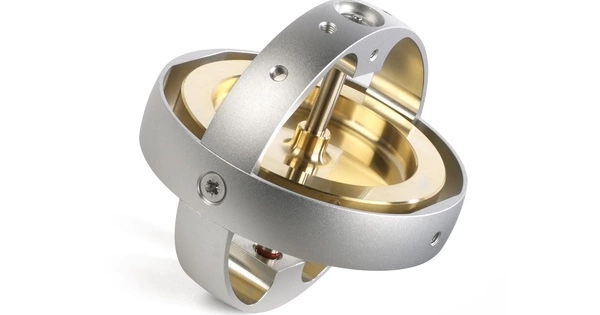A gyroscope is a device that measures or keeps track of orientation and angular velocity. It is a device for measuring and maintaining orientation and angular velocity. It is widely employed in a wide range of applications including as navigation systems, aerospace, robotics, and consumer electronics.
Gyroscopes operate on the angular momentum principle and the conservation of angular momentum. It is a spinning wheel or disc in which the axis of rotation (spin axis) is free to rotate in any direction. According to the conservation of angular momentum, tilting or rotating the mounting has no effect on the direction of this axis.
Other operating principles are used in gyroscopes, such as the microchip-packaged MEMS gyroscopes ubiquitous in electronic gadgets (also known as gyrometers), solid-state ring lasers, fiber optic gyroscopes, and the incredibly sensitive quantum gyroscope.
There are two main types of gyroscopes:
- Mechanical Gyroscope: Traditional gyroscopes are mechanical devices that consist of a spinning wheel or rotor positioned on a system of gimbals that allow it to freely rotate in all three dimensions. When the gyroscope experiences a change in orientation or angular velocity, it opposes the change due to angular momentum conservation. Gyroscopes are important for maintaining stability and providing directional information due to their resistance to changes in orientation.
- MEMS Gyroscope: MEMS gyroscopes are miniature versions of gyroscopes that use microfabrication processes to generate tiny, silicon-based structures capable of detecting changes in angular velocity. Consumer electronics such as cellphones and gaming controllers frequently use MEMS gyroscopes.
Gyroscopes have several important applications:
Inertial navigation systems, such as those used in the Hubble Space Telescope, or inside the steel hull of a submerged submarine, are examples of gyroscope applications. Gyroscopes are also utilized in gyrotheodolites to maintain orientation in underground mining due to their precision. Gyroscopes can be used to build gyrocompasses that supplement or replace magnetic compasses (in ships, aircraft, and spacecraft, as well as vehicles in general), to aid with stability (bicycles, motorbikes, and ships), or as part of an inertial guidance system.
- Navigation: These are used in navigation systems, such as aircraft, ships, and spacecraft, to determine their orientation and help them stay on course.
- Stabilization: These are used in various stabilization systems to keep objects like cameras, drones, and weapons platforms steady and level.
- Robotics: Robots often use gyroscopes for balance and stability, especially in robots that walk or roll.
- Consumer Electronics: Many consumer devices, like smartphones, tablets, and gaming controllers, include MEMS gyroscopes to detect device orientation and provide motion sensing capabilities for gaming and augmented reality applications.
- Aerospace: These play a crucial role in spacecraft and satellites for maintaining precise orientation in space.
Gyroscopes are essential components in many technological systems, providing the ability to sense and control angular motion, which is critical in numerous engineering and scientific applications.
















